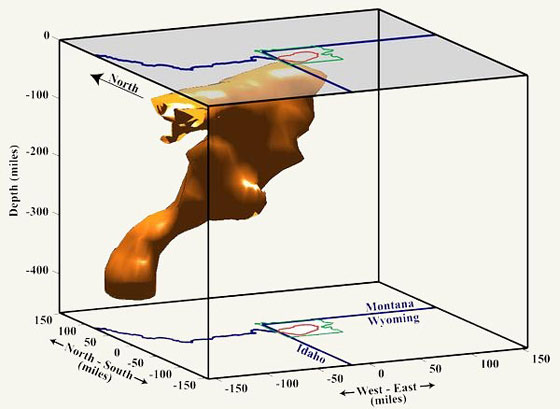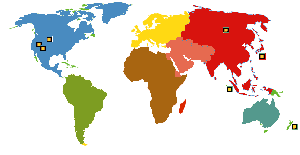How Bad Would A Yellowstone Eruption Be?

image source: National Geographic
Mount St. Helens was tiny compared to the most dangerous category of volcano – the super volcano. The Yellowstone super volcano is located in the Yellowstone National Park of Wyoming. Try to imagine a volcanic eruption 10,000 times stronger than Mount St. Helens – an eruption that would threaten our very survival.
The image above illustrates the size of the Yellowstone super volcano magma chamber superimposed in 3D beneath the state outlines of Wyoming and Idaho. Notice the relative size compared with the green outline of Yellowstone National Park and the red outline of the caldera itself. It’s huge.
Possible Super Volcano Effects
Magma-Ash-Ejecta-Debris would be hurled 30 miles up into the atmosphere
Near devastation of an area the size of North America or Europe
Devastation resulting in economic collapse
Volcanic ash would cover the devastated area to depths ranging from hundreds of feet within proximity, to as much as six inches – thousands of miles away
Anything within 500 miles of the eruption would be completely destroyed
Ash would circle the globe on upper-level winds blotting sunlight for months, followed by a dim and cold volcanic winter lasting for several years
Global temperature would drop, perhaps as much as 20 degrees F
Mini Ice Age
75% of all plant species would die off
World agriculture would be devastated
Mass starvation
Human survival and civilization as we know it would be threatened
Super Volcano locations include…
- Yellowstone in Wyoming (USA)
- Long Valley in California (USA)
- Valley Grande in New Mexico (USA)
- Lake Taupo (New Zealand)
- Aira (Japan)
- Lake Toba (Sumatra)
- Siberian Traps (Russia)
A somewhat alarming statistic regarding Yellowstone is that it’s eruption cycle is a short as the 600,000+ year range and as long as 800,000 years. The last eruption was 640,000 years ago, and we are now within the time frame of possibility. Having said that, it is possible that we will not witness this eruption in our lifetime.
When considering the effects that such an event would have upon the world, it is nearly incomprehensible to create a survival plan.
When considering Yellowstone for example, those who live anywhere near it or downwind from it will have a terrible if not impossible chance of survival. Much of the United States will be covered with ash. Depths would range from 100 or more feet deep near Yellowstone, to 10’s of feet deep further out and even a minimum depth of 5 inches at the extremities of its reach across much of the country.
To put the amount of ash into perspective, the amount of ash and ejecta from Yellowstone could be as much as 11,000,000,000,000 cubic meters (11 trillion), or 2,600 cubic miles.
Preparedness for a super volcano eruption involves location location location. Far away from the immediate ash-fall effects and away from population density where troubles will surely arise in a collapsed aftermath. Several years of stored food. The ability to grow your own food – which may itself be difficult due to the sun being blotted and dim – especially the first year.
Fortunately, the probabilities of are statistically low.
However we just don’t know when…

